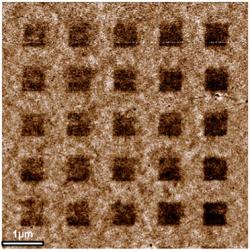Scientists from the U.S. Naval Research Laboratory (NRL) have found a simple and robust means to magnetize graphene using hydrogen. They placed graphene on a silicon wafer and dipped it in cryogenic ammonia with lithium (as this is a quick and gentle method to add hydrogen atoms and make the surface ferromagnetic).
 Part of a large array generated by electron-beam lithography, containing ferromagnetic hydrogenated graphene lattice and the 50 nm nonmagnetic squares
Part of a large array generated by electron-beam lithography, containing ferromagnetic hydrogenated graphene lattice and the 50 nm nonmagnetic squares
Once made, the magnetic graphene was of exceptional quality. The scientists claim that it was surprising how the partially hydrogenated graphene prepared by this method was so uniform in its magnetism and apparently didn't have any magnetic grain boundaries. The NRL group also showed that the magnetic strength could be tuned by removing hydrogen atoms with an electron beam. The impact of the electrons can break the chemical bond between the graphene and the hydrogen, removing the hydrogen from the surface.
The researchers are now trying to answer questions regarding how fine the patterning of hydrogen can be and for how long the ferromagnetism can be stable. Once those questions are answered, this technique could lead to a storage medium with a single hydrogenated-carbon pair storing a single magnetic bit of data, a roughly greater than million-fold improvement over current hard drives.
In January 2015, researchers at the University of California at Riverside found a way to introduce magnetism in graphene while preserving its electronics properties.